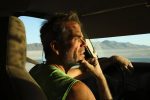
When I was an undergraduate, I had the good fortune of taking a class called the “History of Jazz” from legendary jazz drummer Max Roach. Max came of age in the golden era of jazz. At 18, he played with the Duke Ellington orchestra, and then became one of the seminal figures in Bebop, playing with Charlie Parker, Dizzy Gillespie, Thelonius Monk, and Miles Davis. In 1960, Max composed his seminal album on the civil rights movement, “Freedom Now Suite” (with wife Abbey Lincoln on vocals).
Professor Roach was easy on his students, mostly regaling us with anecdotes about the struggles of black musicians in white America, and the revolutionary and sometimes militant bent of the jazz pioneers.
One week, Max was away, and when he returned, he regaled us with stories of the New Orleans Jazz and Heritage Festival, which he attended with his friend Charlie “Chuck” Mingus. He gushed over the breadth and quality of the music, and told us we should all experience it. It was one of the best and most enduring things I learned in college.
I’ve been many times since, and I’m just back from the amazing 50th anniversary. And despite the cancellations of the Rolling Stones and Fleetwood Mac (due to health issues), there were still 7,000 musicians comprising over 680 groups, performing across 13 stages over eight days. Take that, Coachella.
There was, as always, a massive lineup of boldface headliners. But the highlight for me was the same as every year – the incredible gumbo of local talent. All the great jazz, gospel, blues, Cajun, zydeco, funk, and uniquely New Orleans brass bands. Just as Max said. It’s all so funky, danceable and happy, and a potent reminder that New Orleans is the birthplace of American music, and music is still the glue that binds the community together.
After Katrina, there was such an exodus of people that many wondered if the musical heritage that is fostered by high school marching bands could ever recover. But young people moved back in, neighborhoods have been rebuilt, and New Orleans is popping again. Laissez le bon temps rouler.
Yet as I rolled through the swampy streets with the mossy trees, thick humidity, and the smell of fried seafood, I couldn’t help but feel a sense of dread. Our southeast coast has been devastated by recent super storms, with neighboring Houston experiencing three 100 year storms in as many years. In 2016, a record (500 year) rainfall hit Baton Rouge, and flooded 75,000 structures to the south. Then last fall, Hurricane Michael ripped through the Florida Panhandle, and residents are still desperate for federal assistance. And we all know what happened to Puerto Rico.
Below sea-level New Orleans feels especially vulnerable. The levees have all been rebuilt by the Army Corps of Engineers, but they have proven no match for the fury of a warming planet. And nothing brought it home for me more than meeting artist Richard Thomas. Richard paints the storied musicians of New Orleans, and has shown at the Festival nearly every year. But one painting he displayed captured the stark reality of life in Louisiana.
After Katrina hit, Richard, like thousands of others, was evacuated and relocated. He told me the harrowing tale of getting on a bus with no clue where he was heading. Turned out to be South Larose, a small town in the bayou populated by Cajuns, those pioneer French Canadian immigrants. Richard, an African American, told me of the incredible love the community showed him, and how he was welcomed each night into a different home for dinner. He decided to repay their kindness by painting the festival poster for nearby Houma’s annual Voice of the Wetlands Festival.
This stylized interpretation of a flood and how Louisianans cope with catastrophe is biblical in scope. But instead of animals “marching in two by two” to the arc, Louisianans are floating down the muddy river on the roofs of their homes, serenaded by legendary New Orleans musicians. Black and white folks are dancing together serenely, a brass band is blowing in a rowboat, and atop a teetering water tower is a full Cajun band. Everywhere you look there are musicians playing, and in the background is a crumbling Washington D.C. and New Orleans, symbols of the systemic failure to protect their citizens. But the sun is rising, the sky is pink, and “God’s promise is still with us,” the artist remarked about the work.
I asked Richard if the painting was about despair. He said no, it’s about the resilience of the people. For even in times of deep human tragedy, we have the power to lift each other up – through love. And music. A powerful medicine indeed.
Billy Fried hosts “Laguna Talks” on Thursday nights at 8 p.m. on KX93.5 and can be reached at [email protected].




